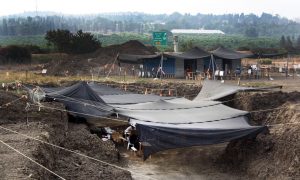Hundreds of hand-axes made half a million years ago were unearthed at Jaljulia, near Kfar Saba, next to one of Israel’s busiest roads.

Archaeologists believe that the site contains artefacts and trances of habitation left by homo erectus, a species of early humans. The site contains hundreds of flint hand-axes typical of the ancient Acheulean culture that existed in the Lower Palaeolithic era from about 1.5 million to 200000 years ago. The Acheulean industry is usually associated with homo erectus and early homo sapiens. The presence of this type of hand axes has been used to trace the early human migration out of Africa into Asia and Europe.
The site appears to have been occupied repeatedly indicates that prehistoric humans possessed a geographic memory of the place, and could have returned there as part of a seasonal cycle. Presence of a stream, vegetation and an abundance of animals might have been key factors encouraging them to return. According to Maayan Shemer, there are only two sites in Israel whose estimated age is close to Jaljulia – one in Kibbutz Eyal, approximately 5km to the North, and the other, dated to a slightly later cultural phase, at Qesem Cave located approximately 5km to the South.

(after Israel Antiquities Authority & The Guardian)